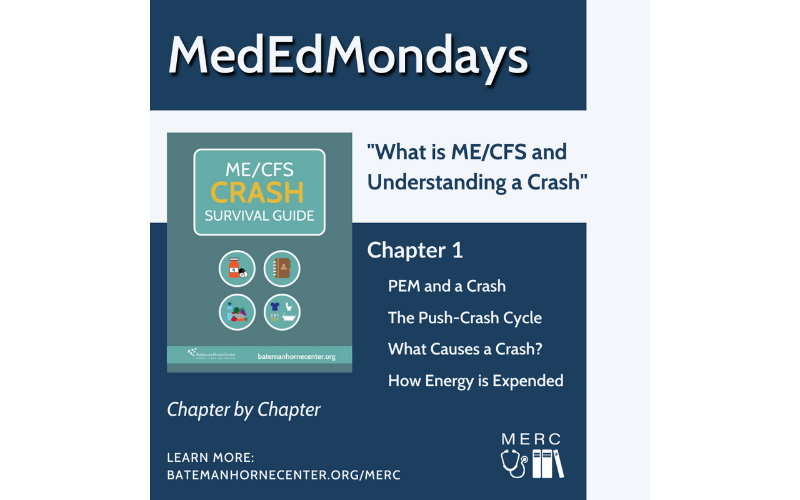This blog post covers the first chapter of the ME/CFS Crash Survival Guide. The information provided can also apply to individuals with long COVID and other multi-system chronic complex illnesses that have a PEM component.
Click here to download the entire guidebook.
Chapter 1: What is ME/CFS and Understanding a Crash
Living with diseases like ME/CFS requires the affected individual to understand the defining characteristic of the disease, post-exertional malaise (PEM), and what it means when the body is pushed into a deep state of PEM, known as a crash. Awareness about how crashes occur, and how to meet the body’s critical needs during a crash, will afford the individual more control over their healing process and living with the disease.
What is ME/CFS?
Myalgic encephalomyelitis/chronic fatigue syndrome, commonly referred to as ME/CFS, is a disease characterized by profound fatigue, cognitive dysfunction, sleep abnormalities, autonomic manifestations, pain, and other symptoms that worsen with activity.
Understanding ME/CFS, PEM, and a Crash
The body functions on an energy consumption and production system. When energy is expended an equal or greater amount of restoration is needed to return to baseline. This often comes in the form of rest, supportive medication, nutrition, and rehydration. Each day this energy balance must be restored for the body to function and perform properly.
In ME/CFS when the cellular energy expenditure exceeds the body’s ability to produce energy, the result is a drastic reduction in functional capacity, which was not present prior to disease onset. This physiological phenomenon is known as post-exertional malaise (PEM) which represents a temporary worsening of all aspects of the illness until some degree of energy stores are restored.
PEM is the body’s inability to recover normally following physical, cognitive and emotional effort, as well as orthostatic, environmental, and sensory stress. The onset of PEM is often delayed in presentation, occurring 12- 72 hours after the trigger(s), and can last hours to weeks and even months at a time depending on the severity of the energy insult.
Patients experiencing PEM often describe “flu-like symptoms” (profound fatigue, weakness, fever, headache, dizziness, sore throat, chills, muscle and joint pain, enlarged lymph nodes), worsened cognitive symptoms (insomnia, brain fog, word-finding and concentration difficulties), and increased sensitivity to stimuli (noise, light, sound, odor, movement). Periods of prolonged and severe PEM are referred to as a crash.
Crashes can vary from person to person and episode to episode. Some may be mild resulting in an inability to carry on with daily activities such as cognitive processing or physical tasks. Others can be so severely debilitating it becomes life-threatening due to the individual’s inability to walk, talk, eat, drink, or sit upright.
Once in a crash, the individual must allow their body to recover before resuming activities. It is critical to allow restoration and to avoid a repetitive push-crash cycle.
The Push-Crash Cycle
It is important to understand that crashes harm the body. Repeated crash sequences will threaten an individual’s ability to return to their former baseline function, worsen or expedite harmful disease processes, and hinder the recovery process.
A push-crash cycle is when the individual pushes through the PEM, worsening their physical state, resulting in a crash. Further harm occurs when an individual pushes during the crashed state, never allowing for true energy restoration. This is a repeated injury and insult to the body, which over time will have lasting consequences and decrease overall functional ability.
Consider a stubbed toe: when you stub the toe once, it hurts but heals back quickly. When you continually stub the toe each day, the injury and recovery time worsen and grow exponentially. The body’s cellular energy demands function in the same way. When constantly depleted and pushed into a “debt zone” the body will need even more time, and shifting of body functions, to replenish those stores.
Think of a crash as the body’s way of forcing hibernation to heal. A patient experiences a physical and mental shutdown while their body tries to protect itself as it focuses energy utilization on basic bodily functions. It is critical not to push through a task or activity during a crashed state to avoid perpetuating harm.
Crash restoration takes time, knowledge, patience, and support.
What Causes a Crash?
There are many ways in which the body uses energy. Each of these accumulates an energy debt throughout the day that must be paid back. While much of life is performed at a subconscious level, it is important to be mindful of the ways the body is taxed to ensure adequate restoration is accounted and planned for.
Energy consumers and stressors come in the form of:
- Physical (movement, metabolism, respiration, sitting, standing, etc.)
- Cognitive (thinking, processing)
- Emotional (eustress, distress)
- Orthostatic (upright posture = time with feet on the floor, sitting or standing)
- Environmental and Sensory Stimuli (noise, light, sound, chemicals, movement, etc.)
The threshold response to energy utilization is much lower in ME/CFS, and it is important to be mindful of the ways everyday functioning impacts your cellular energy. Let’s take a common activity such as an audio or video phone call and dissect how we tap into each of these energy consumers
Example: A 10-minute audio or video call
As you can see, this 10-minute conversation tapped into each piece of the body’s energy reserve. This is not to imply that an individual should not engage in conversation, but to point out how seemingly “simple” activities still contribute to the overall energy demand in a day.
Management of energy consumers is key to crash prevention and can affect recovery time.
The remainder of this guidebook will offer ways to approach living with diseases like ME/CFS and equip the reader with knowledge about how to prevent and survive ME/CFS crashes.
This blog post covers the first chapter of the ME/CFS Crash Survival Guide.
Click here to download the entire guidebook.
The information provided can also apply to individuals with long COVID and other multi-system chronic complex illnesses that have a PEM component.
Bateman Horne Center relies on charitable contributions to produce
educational content such as the ME/CFS Crash Survival Guide.
Support our work by donating today!


 Lucinda Bateman, MD, is a renowned clinician, researcher, and educator. Her Johns Hopkins University Medical School training instilled an approach to care that she has employed throughout her career - the patient comes first and the unknown or unexplained does not equate to a lack of proper and compassionate care. Since starting her own practice in 2000, she has served on six boards or committees, been the principal investigator for 45 studies, authored/coauthored 40 journal articles, served as adjunct instructor and adjunct assistant professor in the University of Utah Departments of Preventative Medicine, Internal Medicine, and Anesthesiology, and lectured around the world.
Lucinda Bateman, MD, is a renowned clinician, researcher, and educator. Her Johns Hopkins University Medical School training instilled an approach to care that she has employed throughout her career - the patient comes first and the unknown or unexplained does not equate to a lack of proper and compassionate care. Since starting her own practice in 2000, she has served on six boards or committees, been the principal investigator for 45 studies, authored/coauthored 40 journal articles, served as adjunct instructor and adjunct assistant professor in the University of Utah Departments of Preventative Medicine, Internal Medicine, and Anesthesiology, and lectured around the world.